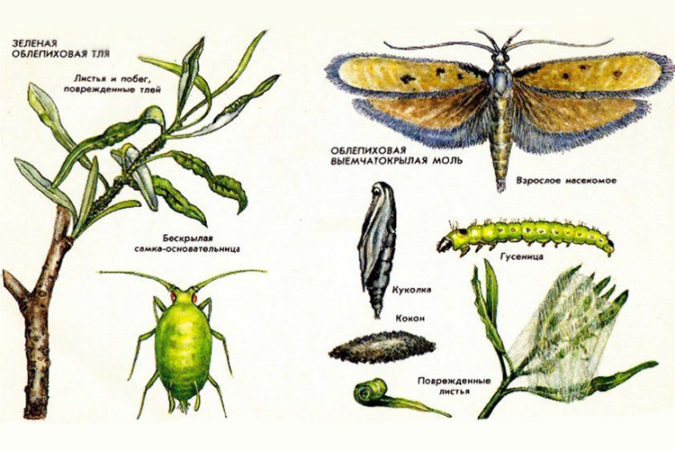How to find out why sea buckthorn leaves turn yellow in summer and eliminate the cause of the problem
The yellowing of the leaves of sea buckthorn in summer is a problem that gardeners often face. Timely identification and relief of the cause will help return the shrub to a healthy state. Why do sea buckthorn leaves turn yellow in summer, we will tell in the article.
The content of the article
Why does sea buckthorn turn yellow in summer
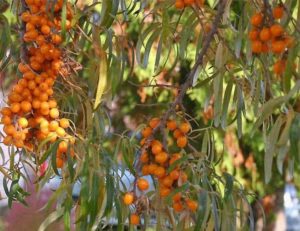
The yellowing of the sea buckthorn leaves in the summer season indicates that negative changes are taking place with the plant.
There are several reasons for this phenomenon:
- lack of food;
- illness;
- pests;
- adverse environmental conditions;
- agrotechnical mistakes.
There are few diseases in sea buckthorn that cause yellowing of the foliage, but all infections have a detrimental effect on the condition of the shrub and can lead to its death the next season.
Insect pests, incorrect agricultural practices, cold summer - all these reasons disrupt the natural development of sea buckthorn and cause premature wilting and yellowing of leaves.
Having determined the cause in time, it is easy to bring the sea buckthorn back to normal.
What to do if sea buckthorn turns yellow
Having determined the cause of the yellowing of the foliage, they begin to eliminate the problem and restore the viability of the plant.
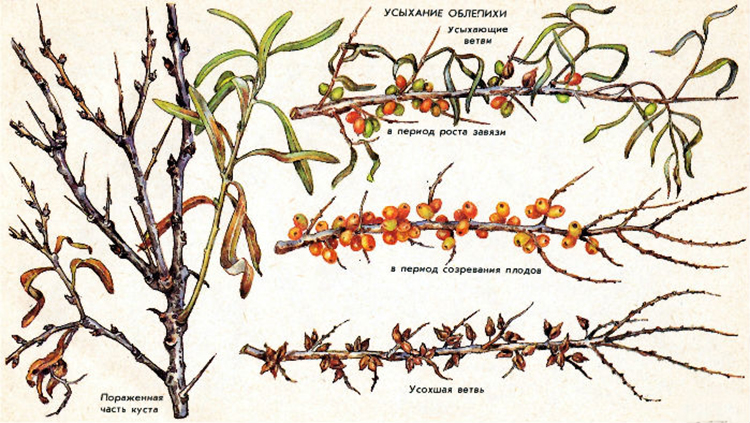
How to find out the cause and eliminate it
Each reason has its own consequences. It is by these sometimes indirect signs that the source of the poor condition of the sea buckthorn is determined.
Lack of food
The process of photosynthesis, which turns leaves green, can be disrupted due to nitrogen deficiency. This leads to yellowing of the leaves in healthy shrubs.
Nitrogen deficiency can occur even if there is sufficient nitrogen in the soil. Dry and cold weather makes it difficult to absorb nutrients from the soil.
But if the weather conditions are normal, and the foliage turns yellow, and there are no other signs, the roots should be fertilized with the following solutions:
- 120 g of urea per 10 liters of water;
- 20 g of ammonium nitrate per 10 liters of water.
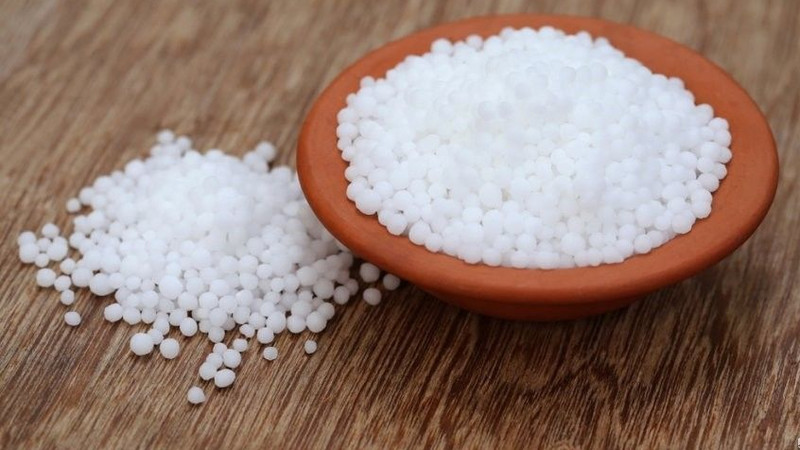
Spraying the foliage with a urea solution also has a positive effect. To prepare the solution, 30 g of urea and 10 liters of water are required.
Diseases
If the yellowing of the foliage is associated with a disease, it is urgent to take measures to cure sea buckthorn.
A neglected disease will lead to the death of the plant. It is easy to identify the disease by its symptoms.
Scab
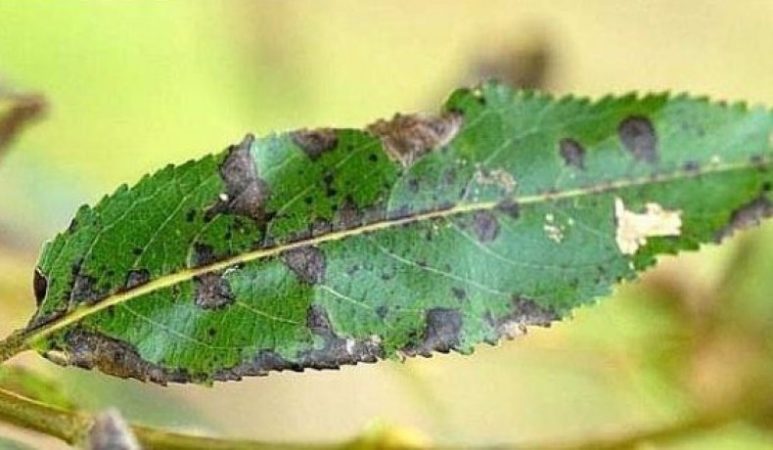
Fungal disease that affects not only foliage, but also shoots, fruits. Spots of yellow-brown color appear on the leaves. Over time, they turn black and begin to shine. The leaf turns yellow and dries up, the fruits are mummified.
Important! The first step to recovery is the collection and destruction of all affected leaves and fruits. If this is not done, in the spring the fungus that has overwintered on the fallen leaves is activated and again affects the sea buckthorn.
Scab control measures include spraying the entire plant with a copper-soap solution. For this, 10 g of copper sulfate and 2 tbsp. l. washing powder is diluted in 10 liters of water.
Spraying with Aviksil solution - 30 g per 10 liters of water - has also proven itself well. Processing is carried out once.
Verticillary wilting
A fungal disease that attacks shrubs between the ages of 5 and 8. Green foliage remains exclusively at the top of the plant. All other leaves turn yellow and fall off.The fruits take on a bright hue, but wither.
The fight against this disease is carried out in stages:
- removal and destruction of diseased branches;
- thinning of sea buckthorn plantings;
- spraying with Bordeaux mixture 2 times a year - in spring and autumn;
- if a problem is found, treatment with any remedy for fungal diseases.
If preventive measures and treatment have not yielded results, the bush must be removed along with the roots and burned. Sea buckthorn can be planted in the same place after 5 years.
Fusarium wilting
The foliage on the bushes turns yellow completely, dries up and falls off much earlier. Fusarium is a very dangerous disease, it is difficult to cure it.
There is only one method of struggle - cutting and destroying the affected branches. If this does not stop the disease, all shrubs are removed from the ground and burned.
Pests
Insect pests are one of the causes of summer yellowing of foliage. Constant observation of sea buckthorn will help to react in time to their appearance.
Sea buckthorn aphid
In addition to the presence of insects on the underside of the leaf, a sign of the appearance of aphids is the premature yellowing of the leaf, its twisting and falling off. The pest sucks juice from young leaves.
Any modern insecticidal agent is effective against aphids. It should be used exclusively according to the instructions.
Those who are against the use of chemicals can spray the plant with folk remedies. To do this, use an infusion of tobacco with onion or garlic husks, tops from tomatoes or potatoes, dandelion leaves. 30 g of laundry soap is added to the infusion and diluted in 10 liters of water.
Sea buckthorn honeydew

Copperhead larvae live on the underside of leaves and feed on their sap. Greens acquire a yellow color, wither and fall off.
The method of struggle is spraying. At the end of May, the plant is sprayed with a solution of "Karbofos" - 30 g per 10 liters of water. After 5 days, it is necessary to carry out the treatment with colloidal sulfur - 100 g per 10 liters.
Unfavorable environmental conditions
If the foliage turns yellow due to a cold or rainy summer, the plant will not be able to help. The most that the owner can do is apply a minimum of root fertilization so that the tree will bear fruit well next year.
Agrotechnical errors
Ignorance of the characteristics of sea buckthorn and improper care of the plant can lead to diseases and yellowing of the foliage.
The most common mistakes include:
- Planting sea buckthorn in the shadow. Being a light-loving plant, it stretches in the shade, gives a weak harvest. Deprived of sunlight, the leaves acquire a yellowish tint.
- Superficial root deepening during planting. Causes them to dry out in hot weather. Without moisture, the leaves wilt and turn yellow.
- Irregular overgrowth removal. With high humidity, it is in dense thickets that fungi actively develop, causing sea buckthorn diseases.
- Lack or excess of fertilizers. A strong plant will not grow on depleted soil, but an excess of fertilizer can burn sea buckthorn. Only by observing the norm will it be possible to grow a healthy bush without yellow foliage and with large fruits.
What to do if the leaves turn yellow and fall off
With yellowing and falling leaves, it is first of all necessary to exclude shrub diseases.
If the sea buckthorn is healthy, and there are no insect pests on it, we can talk about a lack of fertilizer or a lack of moisture, especially in hot summer.
All this applies to plants that have been growing on the site for several years. Young bushes lose their foliage due to the wrong planting site or improper soil.
If fruits fall off

Sea buckthorn berries fall off before ripening due to diseases or insect pests.
If the bushes are healthy and an external examination did not reveal pests, the causes of shedding can be:
- mechanical damage to the roots or the plant itself;
- drought;
- cold;
- lack of water and nutrients;
To avoid the loss of foliage and berries on sea buckthorn, it is necessary to provide it with full care and supervision. If you do not neglect preventive measures, you can grow a strong shrub that bears fruit annually.
Preventive measures
The most effective measure of protecting sea buckthorn from diseases and pests is spraying the shrub.
To prevent the appearance of insects, you must:
- in autumn and spring, treat with Bordeaux mixture;
- at the end of May, spray the plant with Karbofos solution - 30 g per 10 liters of water;
- always have insecticides on hand to process the bush as soon as insects appear on it.
To avoid fungal diseases that cause yellowing of foliage, follow these rules:
- regularly thin out the shrub;
- nitrogen fertilizers are applied annually;
- sprayed with Bordeaux mixture twice a year - in spring and autumn;
- remove dried branches.
Experienced gardening tips
Experienced gardeners will tell you what to do to prevent the sea buckthorn from turning yellow:
- Apply fertilizers and minerals in a timely manner.
- Water the shrub regularly.
- Gently loosen the soil so as not to touch the surface roots of the sea buckthorn.
- Annually trim overgrown plants.
- Carry out preventive spraying in early spring and late autumn.
- Constantly inspect sea buckthorn for pests.
It is interesting:
Guide to planting sea buckthorn seedlings in spring
Conclusion
Premature yellowing of foliage in sea buckthorn can be caused by diseases, pests, improper care and even bad weather conditions.
Constant care of the shrub and preventive measures will help avoid this trouble.
